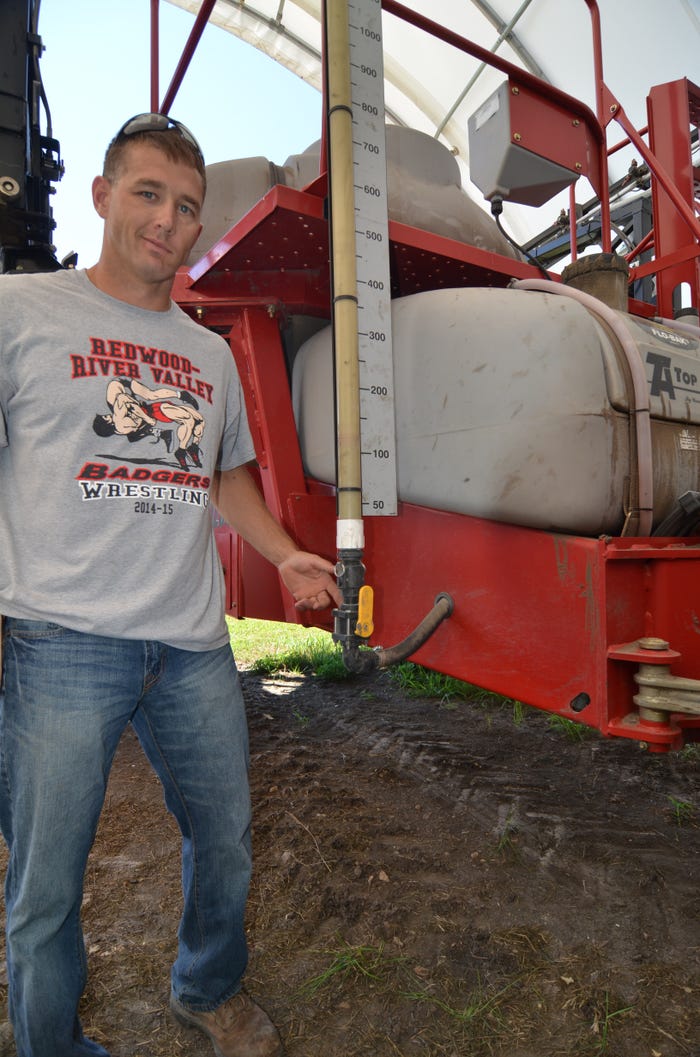April 17, 2017

All the independent experts we’ve talked to are worried about potential issues with the new dicamba-tolerant crop system. In fact, some weed scientists predict dire results for 2017.
It’s up to the applicator to ensure success, because this highly anticipated management tool requires intense application vigilance by users to avoid damaging sensitive nearby crops.
“Every problem we’ve had to date with the new dicamba system was based on off-label applications,” says Ryan Wolf, WinField United agronomy manager. “This is a great technology that delivers another effective mode of action for weed control and resistance management in soybean production; however, we must all step up and use this technology correctly to reap the benefits.”
Following the label is crucial
Wolf has two important tips for anyone adopting the dicamba system. “Number one is read the label. And number two is follow the label,” he advises. “If that happens, I don’t think we’ll have many problems with this system.”
Currently, two low-volatility herbicide products are labeled for use with dicamba-tolerant crops – XtendiMax from Monsanto and Engenia from BASF. Each of these products has its own unique application requirements listed on its product label. “After you’ve selected the herbicide you plan to use with your dicamba-tolerant crop, you need to thoroughly read and follow its label requirements for use,” Wolf cautions. “Each of them has a different set of guidelines that must be obeyed for successful use.”
The two new dicamba products currently have two types of labels: a full Section 3 label that covers dicamba use across a range of crops and a supplemental label covering their use in dicamba-tolerant soybeans and dicamba-tolerant cotton. “It’s the supplemental labels that include the very specific usage guidelines we need to read and follow with the dicamba-tolerant soybean system,” Wolf notes.
Manage drift and volatility
With the exception of dicamba-tolerant soybeans and cotton, most crops are highly sensitive to extremely low doses of dicamba. To mitigate damage to non-target crops, labels for the new products provide detailed guidelines for minimizing dicamba drift and volatility.
“Drift is the physical movement of spray particles coming off the boom during application,” Wolf notes. “As spray droplets exit the nozzle, they’re affected by environmental conditions such as wind. If gravity can’t overcome any prevailing breeze, physical drift can occur.”
To help minimize potential drift, the two new product labels limit application to certain wind speeds and caution applicators to watch for possible temperature inversions. Because each label differs slightly on wind regulations, it’s important to follow the recommendations exactly as stated on the product being used in order to avoid damage to sensitive neighboring crops.
“A number of environmental factors can cause volatility to occur, making it difficult to predict,” Wolf explains. “Volatility occurs as the spray droplet dries on the leaf surface. During spray evaporation, the physical particles change to a gaseous form that is capable of moving in wind to neighboring fields. The new dicamba herbicides developed for use with this system include low-volatility formulations that significantly reduce volatility potential.”
Follow specific application rules
To combat off-target herbicide movement, the product labels for XtendiMax and Engenia include detailed guidelines for application rates, nozzle types, pressure range, boom height, wind speed, adjuvant use and more. And these rules vary between the two labels.
“For example, currently 20 different nozzles are approved for use with XtendiMax, while Engenia allows six different nozzle types,” Wolf notes. “All the nozzles allowed apply extra-coarse to ultra-coarse droplets to limit small particles that can easily move off-target.”
Along with specific nozzle types, the product labels designate minimum and maximum nozzle pressure levels, as well as application speeds.
“Boom height is limited to a maximum of 24 inches above soil surface or crop canopy for both new herbicides,” Wolf says. “This boom restriction mirrors research data showing that the risk of drift drastically multiplies as boom height increases.”
Both new products also require the use of a 110-foot buffer zone between the last row of sprayed soybeans and sensitive crops located downwind when using an application rate of 12.8 fluid ounces per acre of Engenia or 22 ounces per acre of XtendiMax postemerge. “After the wind speed changes direction, the buffer strips can also be sprayed.”
After spraying is complete, a three-rinse procedure should be used to eliminate any remaining traces of dicamba in the sprayer system. “Farmers should carefully follow the cleaning steps listed on each label,” Wolf advises. “I also recommend rinsing the tank as soon as spraying is complete, as well as completely flushing booms and hoses. It’s never a good idea to leave dicamba in the sprayer overnight, or clean-out can become extremely difficult.”
Include drift-control adjuvants, buffer zones
Drift-control adjuvants are also recommended for effective drift management with the dicamba-tolerant system, Wolf notes. Lists of adjuvants and tank-mix partners, along with nozzles approved for use with the two new products may be accessed online at XtendiMax and Engenia. Because the lists of products continue to change and vary between XtendiMax and Engenia, users will need to consult the appropriate online listings for the most current information.
“It is important to understand the required combination of products that is listed on the two labels,” Wolf says. “With XtendiMax, approved drift-reducing agents must be in the mixture when certain other herbicides and adjuvants are used. The designated drift-reducing agents, such as AG16098 adjuvant from WinField United, are specifically designed for use with ultra- and extra-coarse nozzles, and the new dicamba herbicide chemistries.
Protect against dicamba weed resistance
Application rules for XtendiMax and Engenia also extend to weed-resistance management. “Weed resistance to the new herbicides can develop quickly if only partial control is achieved with each application,” Wolf says. “However, when the exact rates and application procedures on the product labels are followed, weed-resistance issues should be minimized.”
While the dicamba-tolerant crop system is a welcome addition to current weed-control programs, it’s only one part of the long-term solution. “To remain effective and provide expected weed control, the new dicamba products should be part of a diversified weed-control strategy that includes multiple modes of action, paired adjuvants and recommended best management practices,” Wolf adds.
Minnesota farmer advice
Matt Tiffany, a fifth-generation farmer from Redwood Falls, Minn., grows foundation soybean seed for Monsanto and has worked with XtendiMax on Asgrow Roundup Ready 2 Xtend soybeans. He was one of 33 farmers in five states that participated in Monsanto’s Ground Breakers closely supervised field trials in 2016.

Redwood Falls, Minn., farmer Matt Tiffany says farmers should examine every nook and cranny of their sprayer to make sure cleanout eliminates all dicamba residue.
“For everybody that has Roundup-resistant weeds, this program is going to be a game changer to control these weeds,” Tiffany says. “We have issues with resistant waterhemp, and we’ve seen excellent control with the Xtend program. But planning ahead is the big key due to the spray requirements – three to 10 mph wind from the correct direction without a temperature inversion imminent – so having the sprayer ready to go is vital to success.”
When he follows all the application guidelines, Tiffany says he has had zero issues with this system. “But the keys to our weed program is a good pre-emerge, followed by a good residual put down with your post-emerge application – ideally applied to four-inch tall weeds.”
Two other tips that Tiffany recommends: follow the exact sprayer cleanout procedures, and communicate with your neighbors about this program.
“Learn where the hang up points are in your sprayer, and possibly outfit your sprayer for a little easier clean out. We've added some valves where the sprayer manufacturer didn't have them, just so we can flush and rinse booms to get at the spots that are a little tougher – so we can remove every bit of residue.”
Along with being a good applicator, being a good neighbor is equally important to Tiffany. “We’ve had multiple neighbors over the years and have never had an issue because we work with them and follow product and application recommendations.”
About the Author(s)
You May Also Like






